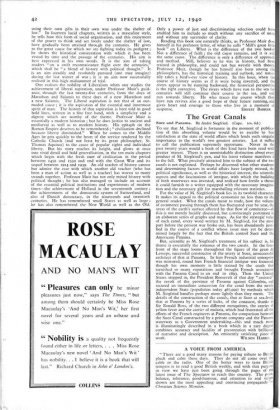The Great Canals
Suez and Panama. By Andre Siegfried. (Cape. los. 6d.)
To say that M. Siegfried is fortunate in the moment of publics. tion of this absorbing volume would be to ascribe to him satisfaction at the state of world affairs which lends such singular importance to the world's two greatest arteries. Let it suffice to call the publication supremely opportune. Never in the past twenty years would a book of this kind have been read with greater :nterest. There is an unmistakable distinction about every product of M. Siegfried's pen, and his latest volume manifests it to the full. What precisely attracted him to the subject of the two canals is not explained. Perhaps he discerned what other students and determining factors in world affairs have largely missed, the political significance, as well as the historical interest, the scientific aspects and the fascinations of intrigue, with which the building of both waterways was invested, and realised how fertile a theme it could furnish to a writer equipped with the necessary imagina- tion and the necessary gift for marshalling relevant statistics.
For the value of M. Siegfried's book lies in its twofold character. It makes its appeal to the political economist no less than to the general reader. What the canals mean to trade, how the volume of commerce passing through them has fluctuated year by year, the areas of the earth's surface affected by that flow of commerce—all this is not merely lucidly discussed, but convincingly portrayed in an elaborate series of graphs and maps. As for the strategic value of each canal, every word written by M. Siegfried, for the most part before the present war broke out, has been abundantly justi- fied in the course of a conflict whose issue may yet be deter- mined largely by the fact that the British control Suez and the Americans Panama.
But, scientific as M. Siegfried's treatment of his subject is, his theme is essentially the romance of the two canals. In the fore- front of the stage looms throughout the figure of the great de Lesseps, successful constructor of the artery at Suez, unsuccessful architect of that at Panama. In him French industrial enterprise was mirrored, round him French financial intrigue was focussed, though his own memory is little stained by the crash that tarnished so many reputations and brought French association with the Panama Canal to an end in 1893. Then the United States stepped in, the President Roosevelt of that day " assisted" the revolt of the province of Panama against Colombia, and secured an immediate concession for the canal from the newly independent State (population today 467,000) by methods which M. Siegfried handles perhaps more lightly than they merit. The details of the construction of the canals, that at Suez at sea-level, that at Panama by a series of locks, of the conquest, thanks to Sir Ronald Ross, of the two different mosquitoes, the carrier of yellow fever and the carrier of malaria, which had frustrated all the efforts of the French engineers at Panama, the comparison between the Suez Canal constructed by a private company and the Panama waterway as a Government undertaking—this and much more is illuminatingly described in a book which in a rare degree combines accuracy and lucidity of presentation with brilliance of narrative and description. An eminently satisfying piece of


























 Previous page
Previous page